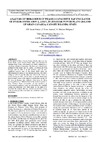Identificador persistente para citar o vincular este elemento:
https://accedacris.ulpgc.es/jspui/handle/10553/70049
| Título: | Analysis of behaviour of phase s capacitive tap insulator of interconnection 1, 220 kv, in jinamar power plant (Island of gran canaria, Canary Islands, Spain) | Autores/as: | García Muñoz, J. M. Torres Santana, J. Martínez Melgarejo, M. |
Clasificación UNESCO: | 332203 Generadores de energía 332204 Transmisión de energía 3306 Ingeniería y tecnología eléctricas |
Palabras clave: | Capacitive Dirtiness Field Tests Shortcircuit Tap Insulator |
Fecha de publicación: | 2011 | Publicación seriada: | Renewable Energy And Power Quality Journal | Resumen: | In the island of Gran Canaria, Canary Islands, there are two Power Plants called Jinamar Power Plant and Barranco de Tirajana Power Plant, both property of Unelco Generacion, a subsidiary of Endesa Generacion. The first one is placed in the northeast of the island, near its capital, Las Palmas de Gran Canaria, and the other is in the southeast, near the most significant touristic area of the island. Both plants are interconnected by means of four transmission lines, two with a voltage of 220 kV and the other two with 66 kV. Since its commissioning in 1995, several phase to ground shortcircuits have occurred in one of the capacitive tap insulators in the 220 kV lines, in Jinamar side, without a clear cause for them, causing problems of different kind in the electrical system of Gran Canaria. From construction of tap insulators to environmental conditions, every possible factor was carefully studied and laboratory tests were made. In this paper it is described the analysis that was carried out and how a deep study of every possible cause drove to a definitive solution of the problem. El artículo expone y analiza la problemática existente en uno de los pasatapas capacitivos, concretamente el de la fase S, de la línea de 220 kV que interconecta las dos centrales eléctricas existentes en la isla, Barranco de Tirajana y Jinámar, pasatapas instalado en esta última y que conecta la línea con la correspondiente borna del transformador elevador situado en la central. Tal problemática derivaba en periódicos cortocircuitos monofásicos desde su puesta en servicio 15 años antes del trabajo realizado. En el artículo se describe con detalle el profundo análisis que llevó a encontrar la causa última de la ocurrencia de los citados cortocircuitos y, en consecuencia, la solución definitiva al problema. |
URI: | https://accedacris.ulpgc.es/handle/10553/70049 | DOI: | 10.24084/repqj09.266 | Fuente: | Renewable Energy and Power Quality Journal [ISSN 2172-038X], v. 1 (9), p. 136-141 |
| Colección: | Artículos |
Visitas
59
actualizado el 02-mar-2024
Descargas
69
actualizado el 02-mar-2024
Google ScholarTM
Verifica
Altmetric
Comparte
Exporta metadatos
Los elementos en ULPGC accedaCRIS están protegidos por derechos de autor con todos los derechos reservados, a menos que se indique lo contrario.
